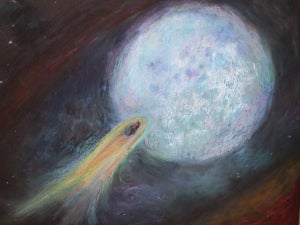Bagging new comets has become almost routine with robotic telescope surveys and eagle-eyed satellites, but the most recent stellar sighting promises to open a new chapter in our understanding of these titanic masses of ice and dust. Astronomers have witnessed a giant cometlike body end its life in a kamikaze plunge into a fiery young star more than 3,200 light-years away.
Using the 9.2-meter Hobby-Eberly Telescope at the McDonald Observatory in Texas, a team of astronomers from Pennsylvania State University (Penn State) kept watch over an infant star only 100,000 years old, searching for the telltale signs of any cometary activity. By breaking the ancient starlight into a high-resolution spectrum, the team uncovered the chemical fingerprint of sodium in a 100-kilometer-diameter comet as it fell into its blazing parent star. Observations taken over 31 days in the autumn of 2003 also showed clouds of hydrogen and helium absorbing the young star’s light.
“Something happened on a time scale of days or less that created an enormous change in the spectrum of this star while the astronomers were looking,” explains Eric Feigelson, a Penn State professor who specializes in the study of young stars. “This is a quite extraordinary event!”
“We know how hot the star is and how close to the star the neutral sodium atoms can survive,” says coinvestigator Abhijit Chakraborty, a postdoctoral researcher in astronomy at Penn State. “From that, and from the motion of the cometlike body during infall onto the star, we calculated how large the body would have to be to get this close to the star — one-tenth of the distance between the Sun and the Earth — before vaporizing.”
Known as a Herbig Be object, kHalpha 234 is six times more massive than our Sun and is still embedded in its birthing nebula associated with the NGC 7129 star-forming region in the constellation Cepheus. “This discovery is significant because this is the youngest star ever found with this kind of infall of a cometlike body,” says team leader Jian Ge, professor of astronomy and astrophysics at Penn State. Other much older, budding stars, like Beta (b) Pictoris with its disk of protoplanetary material, have shown spectroscopic variations that point to star-grazing comets or falling, disintegrating planetesimals with sizes of tens of kilometers. “This detection indicates that solid bodies 100 kilometers in size can form this early around a star,” adds Ge.
Publishing their findings in the upcoming May 1 issue of Astrophysical Journal Letters, the team plans to continue monitoring kHalpha 234 to determine the frequency of such events and in hopes of furthering our understanding of the chaotic environments around newborn stars.










